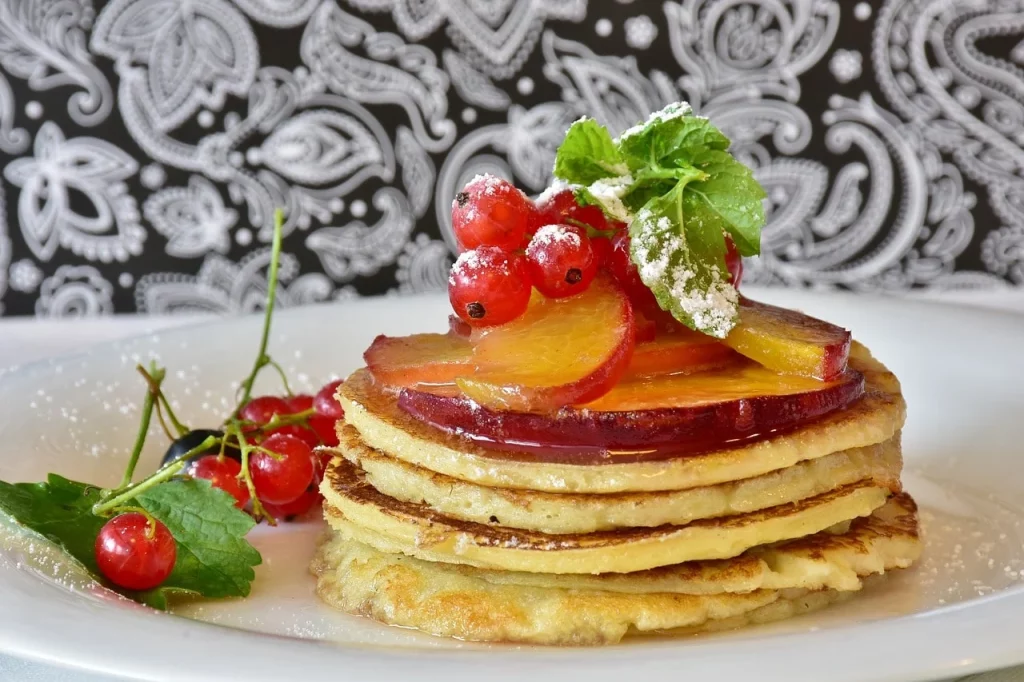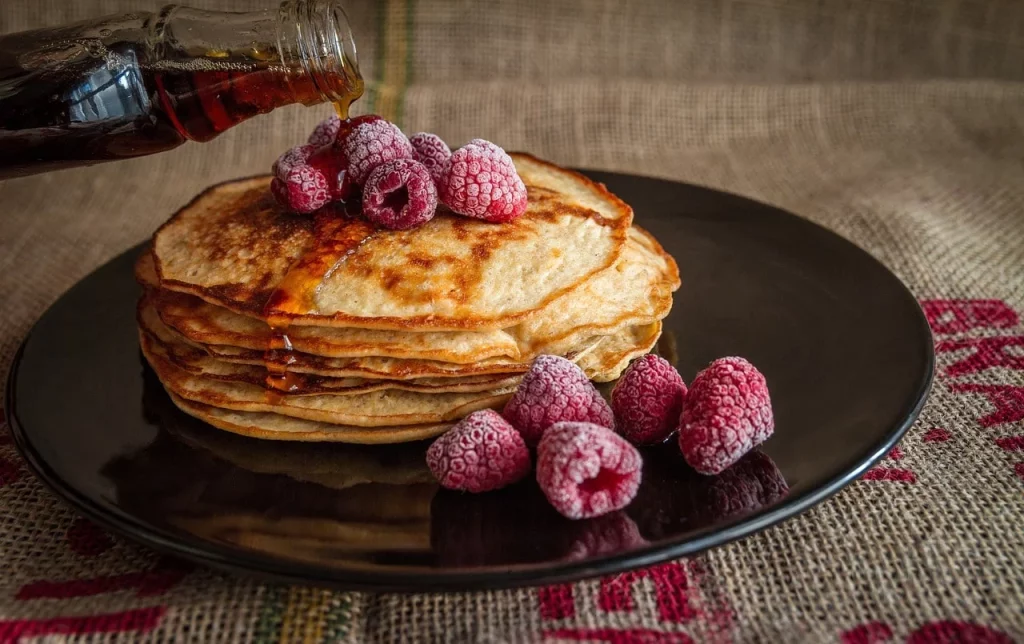Welcome to the world of pancakes, a delightful treat that has captivated taste buds around the globe! Have you ever wondered about the story behind these fluffy wonders? Pancakes are not just a breakfast staple; they are a canvas of culinary creativity and a testament to simple ingredients creating extraordinary experiences.
In this article, we’ll explore the fascinating world of pancakes, from their humble beginnings to their status as a beloved comfort food. Whether you’re a pancake freak or just a curious foodie, join us on this delicious journey where every flip and drizzle tells a story.
Life is like a pancake. It can be sweet or savory, depending on what you add to it.
Anonymous
Pancake Facts
Prepare to enrich your knowledge with fascinating pancake facts. Read carefully, because your knowledge is going to be tested in the quiz at the end of this article, proving your status as a pancake expert.
- Pancakes have been a staple in various cultures for over 30,000 years, making them one of the oldest known prepared foods.
- The term “pancake” first appeared in English in the 15th century, but the concept existed much earlier under different names across cultures.
- In the United States, pancakes are often associated with breakfast, while in Europe, they can be a dessert or even a main course.
- Pancakes can be thin and crêpe-like or thick and fluffy, depending on the recipe and cooking method.
- The world record for the largest pancake ever made was set in Rochdale, England, in 1994, measuring 15 meters in diameter.
- Pancake recipes vary greatly across regions, incorporating different ingredients like buckwheat, buttermilk, or yeast.
- Shrove Tuesday, known as Pancake Day in the UK, is a day for consuming pancakes before the start of Lent.
- In France, the term “crêpe” refers to a thin pancake, traditionally made with wheat flour, and is a staple of French cuisine.
- Russian blinis, made with yeast and buckwheat flour, are traditionally served with sour cream and caviar.
- The Aebleskiver, a Danish pancake, is spherical in shape and often filled with fruit or jam.
- In Ethiopia, injera is a type of sourdough pancake that’s a staple in Ethiopian cuisine.
- Pancakes can be made vegan by substituting eggs and dairy with ingredients like bananas or applesauce.
- Japanese Okonomiyaki is a savory pancake containing a variety of ingredients, reflecting its name, which means “grilled as you like it”.

- The phrase “flat as a pancake” has been used since the 17th century to describe something that is extremely flat.
- In the Netherlands, pannenkoeken are large and thin, often eaten for dinner with both sweet and savory fillings.
- Pancake races, where participants run while flipping pancakes in a skillet, are a traditional event in the UK and other countries.
- The first ready-mix food to be sold commercially was Aunt Jemima pancake flour, invented in 1889.
- Pancake art, where batter is “drawn” into shapes and images on the griddle, has become a popular trend on social media.
- Maple syrup, a common pancake topping, was first collected and used by the indigenous peoples of North America.
- In some cultures, pancakes have symbolic meanings, such as signifying sun and warmth in pagan rituals.
- Sweden has a special day called Fettisdagen, where a special type of pancake called semla is traditionally eaten.
- Korean kimchi pancakes, known as kimchijeon, are a popular dish made with kimchi and a variety of other ingredients.
- The Guinness World Record for the most pancakes served in eight hours is 34,818, achieved by Co-operative Union Ltd in Manchester, UK.
- During the Russian celebration of Maslenitsa, a week-long festival, pancakes or blinis are eaten to symbolize the end of winter.
- In some parts of the United States, “pancake feeds” are popular community events, often organized as fundraisers.
- The phrase “flipping pancakes” is often used to describe the act of turning them over in the pan to cook both sides.
- Pancakes can be a canvas for culinary creativity, featuring unique toppings like edible flowers, gold leaf, or exotic fruits.
- In Australia and Scotland, pancakes are sometimes called “drop scones” because the batter is dropped from a spoon into the pan.

- The nutritional content of pancakes can vary widely based on ingredients, with some versions being high in protein or gluten-free.
- The world record for the most people making pancakes simultaneously is 890, set in Manchester, England, in 2012.
- Cultural variations of pancakes include American flapjacks, French crêpes, Russian blinis, and Ethiopian injera.
- In South Africa, pancakes are traditionally eaten on rainy days, believed to bring good luck.
- Some restaurants specialize in pancakes, offering a wide range of types and toppings, and are sometimes known as “pancake houses”.
- Pancake tossing is a skill often showcased in cooking demonstrations and competitions.
- In parts of Europe, particularly Eastern Europe, pancakes are often filled with jam, cheese, or ground meat.
- Sourdough pancakes, made with fermented batter, are a traditional recipe in some cultures, offering a tangy flavor.
- The earliest known pancake-like food was found in the stomach of Ötzi the Iceman, a 5,300-year-old mummy discovered in the Alps.
- In some Asian cultures, pancakes are made with rice flour and stuffed with savory fillings, such as in Vietnamese bánh xèo.

- During the Middle Ages, pancakes were often made using barley, rye, or oats, as wheat flour was expensive.
- Blueberry pancakes are a popular variation in North America, often served with maple syrup and butter.
- Gluten-free pancakes can be made using alternative flours such as almond, coconut, or rice flour.
- Pancakes have been featured in art and literature for centuries, symbolizing homeliness and comfort.
- In Greek cuisine, tiganites are small, fried pancakes typically served with honey and walnuts.
- Pancake makeup, a term in the cosmetic industry, originated from the thick, layered foundation similar to the texture of a pancake.
- Pancake Day races in the UK date back to 1445, with the most famous being held in Olney, Buckinghamshire.
- Some health-conscious variations include using whole wheat flour, adding flaxseed, or incorporating protein powder.
- In Iceland, Pönnukaka are traditional pancakes, thin and soft, often eaten rolled up with sugar.
- Pancake lenses, in photography, refer to thin, flat lens designs that resemble the shape of a pancake.
- “Pancake Day” is celebrated in different ways around the world, often involving making and eating pancakes.
- Some people believe that the first pancake always turns out poorly, a notion that has become a common kitchen superstition.
Pancake Myths

Let’s dive deeper into some myths about pancakes. It’s time to uncover the actual truth behind them. If you know more, just put them in the comments so I can add them to the list.
- Pancakes Are Only a Breakfast Food
They are versatile and can be enjoyed at any meal. Whether it’s breakfast, lunch, dinner, or even a snack, pancakes can be customized with various toppings and fillings to suit any time of day. - Pancakes Are Unhealthy
While traditional pancakes can be high in sugar and carbs, they can be made healthier. Using whole grain flours, adding fruits, and minimizing sugary toppings can transform them into a nutritious option. - Pancakes Are Difficult to Make
Pancakes are actually quite simple to whip up. Basic recipes require just a few common ingredients, and the batter can be prepared in minutes. Plus, they’re a fun and easy dish for cooking beginners. - Pancakes Always Need Syrup
Pancakes can be topped with a variety of ingredients, like fresh fruit, yogurt, honey, or even savory options like cheese and eggs. There’s no limit to how creative you can get with your toppings. - Only Flour-Based Pancakes Are Tasty
They can be made with a variety of flours or even flourless options like bananas or oats. These alternatives not only add unique flavors but also cater to different dietary needs, such as gluten-free or vegan diets.
No products found.
Pancake Quotes

From fluffy to crispy, pancakes come in all shapes and sizes, each with its own story. Here are a few quotes that reflect the universal love and diverse opinions about them.
Pancakes don’t make the world go ’round. Pancakes are what makes the ride worthwhile.
Frankfurter Allgemeine
This quote highlights the joy and satisfaction that pancakes bring to life, emphasizing their role in making everyday experiences more enjoyable.
There’s nothing a pancake can’t cure.
Rachael Ray
Rachael Ray humorously suggests that pancakes have a magical quality to make everything better, reflecting on their comforting and delightful nature.
In a world full of plain bagels, be a pancake.
Unknown
This quote encourages individuality and uniqueness, using the humble pancake as a metaphor for standing out in a world full of common things.
Pancakes are love in circular form.
Anonymous
This one poetically describes pancakes as a symbol of love, attributing emotional warmth and affection to their round shape.
When life gives you lemons, make lemon pancakes.
Unknown
A twist on the classic saying about making lemonade from lemons, this quote suggests turning unexpected challenges into something sweet and enjoyable, like lemon pancakes.
Pancake FAQ

I hope you enjoyed the pancake quotes! Now, brace yourself for the FAQ section, the last stop before my challenging quiz. Read carefully.
- Are pancakes and waffles the same?
While pancakes and waffles might share some ingredients like flour, eggs, and milk, they’re quite different in texture and cooking method. Pancakes are usually softer and cooked on a griddle or frying pan, giving them a smooth surface. Waffles, on the other hand, are cooked in a waffle iron, which gives them a crispy exterior and a unique grid pattern. - Can pancakes be frozen?
Absolutely! If you’ve made too many pancakes, don’t let them go to waste. Let them cool, separate them with baking paper, and pop them in a freezer bag. They can be reheated in a toaster or microwave, making for a quick and delicious breakfast on busy mornings. - Are pancakes gluten-free?
Not traditionally, but they can be! Regular pancakes contain flour, which has gluten. However, there are many gluten-free options available, like using almond flour, rice flour, or commercially available gluten-free pancake mixes. These alternatives can be just as tasty and fluffy. - Who invented pancakes?
Pancakes have been around for centuries, making it hard to pinpoint a single inventor. They date back to ancient Greece and Rome, where versions of pancakes were made from wheat flour, olive oil, honey, and curdled milk. Every culture has its own take on the pancake, evolving over time to what we enjoy today. - Are pancakes bad for you?
Like many foods, pancakes in moderation can be part of a balanced diet. Traditional pancakes can be high in carbs and sugar, especially when topped with syrup and butter. However, you can make them healthier by using whole wheat flour, adding fruits like blueberries or bananas, and reducing sugar in the batter.
No products found.
Pancake Trivia

Welcome to the ultimate pancake quiz! If you don’t stack up the right answers, you might just find your syrup turning into molasses!
Conclusion
Pancakes, those fluffy ambassadors of the breakfast world, have a way of bringing smiles to our mornings. We’ve explored their fascinating facts, but remember, the true magic of pancakes lies in the joy they bring to our tables.
So, next time you flip a pancake, think about this: “If pancakes could talk, what would they say about your flipping skills?” Let me know your ideas in the comments.
3 Sources Used For This ArticleDifference Between Pancakes And Waffles – Know The Difference
History – Everything Crepe


